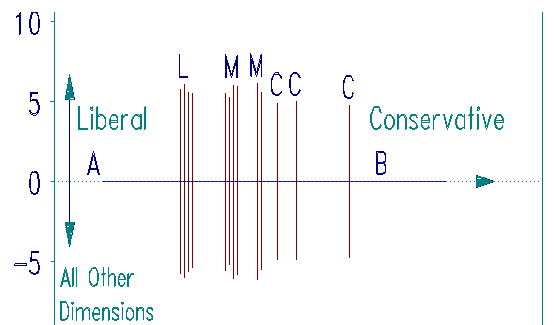
Rasch dimensional analysis. Moulton MH. … 1995, 8:4 p.398
The greater part of measurement is taken up with identifying a variable to be measured and then gathering data dominated by that variable. When, as generally occurs, the data reflect the influence of additional variables, those data show misfit to the Rasch model. When misfit becomes substantial, Rasch analysis of the data becomes increasingly ambiguous. To reduce the difficulty of dealing with such data, "Rasch Dimensional Analysis" (RDA) has been developed to filter out the effects of unwanted dimensions in order to expedite the analysis of a particular variable.
Suppose you have a set of interviews and want to measure the respondents on a liberal/conservative dimension. One approach is to read the interviews and identify a set of liberal and conservative indicators chosen to define an approximately unidimensional variable. But this requires finding the indicators in the interview. You must make multiple separate decisions on which respondent statements reflect liberal or conservative positions, and each of those decisions must be reconciled with your intended variable.
RDA takes a different approach. Instead of seeking multiple indicators that mark a particular dimension, you simply choose two respondents (or items) that you decide represent opposite poles of your target dimension. Then two measurements are estimated for each other respondent (or item). These measures are the distances between that respondent's interview and the interviews of the two polar respondents. Simple geometry converts these distances into measures along the dimension defined by the chosen poles.
There are three steps:
1. Choose two persons (A,B) to define the opposite poles of your
dimension of interest using your judgement. These persons should
differ dramatically on your target dimension, e.g.,
liberal/conservative, but otherwise be similar.
2. Estimate the absolute logit distances (R,S) between each respondent (C) and the two polar respondents (A,B) by any convenient method, e.g., for dichotomous coding of interview items, a "Poisson" distance between a pair of respondents is [loge(1+disagreements)]. Similarly estimate the distance (T) between polar persons (A, B).

3. Use Pythagoras' theorem to project each person onto your dimension of interest. The result is a measure of the liberality (or conservativeness) of each respondent along the dimension defined by your choice of A and B.
The measure, x, from pole A toward pole B of respondent C is:
x = (T*T + R*R - S*S)/2T
I applied RDA to interviews of 15 political figures influential in Chicago school governance. Respondents were coded according to their opinions on a number of educational issues, but were not asked about their political philosophies. To define a liberal/conservative dimension, I chose as polar reference points a well-known liberal Democrat from the House of Representatives and a staff member of a well-known conservative Republican Senator. A conventional Rasch analysis of these data was unable to separate respondents along any useful dimension.
The results from RDA, however, were clear-cut, as the plot testifies. In the plot, A marks the polar liberal and B the polar conservative. L marks respondents previously thought to be liberal, M respondents previously thought to be moderate, and C respondents previously thought to be conservative. RDA has succeeded in measuring along my bipolar dimension.

Rasch dimensional analysis. Moulton MH. … Rasch Measurement Transactions, 1995, 8:4 p.398
| Forum | Rasch Measurement Forum to discuss any Rasch-related topic |
Go to Top of Page
Go to index of all Rasch Measurement Transactions
AERA members: Join the Rasch Measurement SIG and receive the printed version of RMT
Some back issues of RMT are available as bound volumes
Subscribe to Journal of Applied Measurement
Go to Institute for Objective Measurement Home Page. The Rasch Measurement SIG (AERA) thanks the Institute for Objective Measurement for inviting the publication of Rasch Measurement Transactions on the Institute's website, www.rasch.org.
| Coming Rasch-related Events | |
|---|---|
| Jan. 16 - Feb. 13, 2025, Fri.-Fri. | On-line workshop: Rasch Measurement - Core Topics (E. Smith, Winsteps), www.statistics.com |
| Apr. 8 - Apr. 11, 2026, Wed.-Sat. | National Council for Measurement in Education - Los Angeles, CA, ncme.org/events/2026-annual-meeting |
| Apr. 8 - Apr. 12, 2026, Wed.-Sun. | American Educational Research Association - Los Angeles, CA, www.aera.net/AERA2026 |
| May. 15 - June 12, 2026, Fri.-Fri. | On-line workshop: Rasch Measurement - Core Topics (E. Smith, Winsteps), www.statistics.com |
| June 19 - July 25, 2026, Fri.-Sat. | On-line workshop: Rasch Measurement - Further Topics (E. Smith, Winsteps), www.statistics.com |
The URL of this page is www.rasch.org/rmt/rmt84h.htm
Website: www.rasch.org/rmt/contents.htm